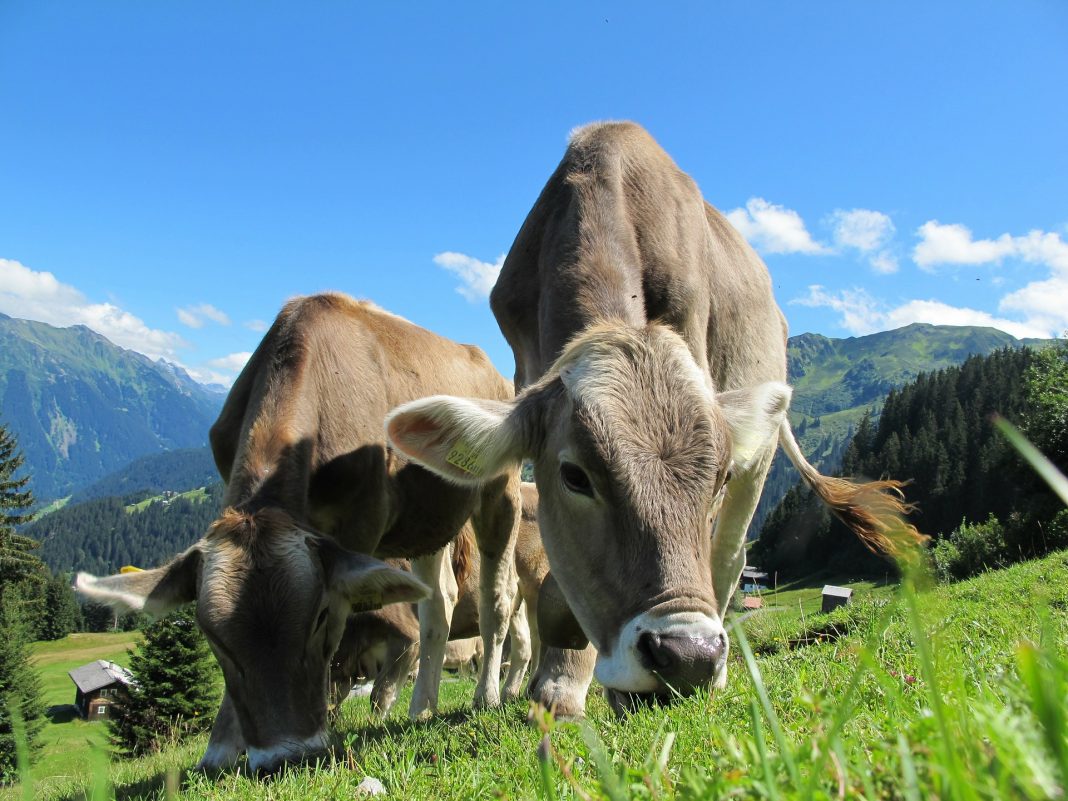| Issue #36 • November/December, 1995 |
Have you ever had this happen to you? You’ve opened the refrigerator door for a cold, refreshing glass of milk only to find an empty jug. You’ve already made two trips to the grocery store this week, and at the price of milk . . . well, there’s just got to be a better way.
Relax. There is. Enter the family milk cow.
Why a cow instead of a goat? Cows are big and clumsy, and don’t they eat a lot? To be quite honest, both cows and goats each have their own distinctive advantages and disadvantages.
Goats are small and docile and smart, and they are famous for their ability to escape most fences. On the other hand, milk cows are big and docile, and they can usually be kept in a pasture by as little as a few strands of wire, providing that their nutritional needs are met.

Goats give about a gallon a day, which is quite enough for the average family’s needs. A family milk cow will often give eight to ten gallons a day. This is adequate for a family’s milk supply, as well as an extra amount for treats such as cream, butter, yogurt, and cheese, and there will still be enough left over to raise a calf for beef. And although both the initial cost and subsequent upkeep of a cow are much higher than those of a goat, the return per annum and the final resale of the cow are also much higher.
Given the choice, we decided to try our hand with a cow. If you think you might enjoy working one, read on, and we’ll try to share a few pointers we learned along the way.
How to find the right cow
Finding a cow sounds like a simple matter. You go to a farm, point at a cow, and ask the price, right? Wrong. We made a lot of mistakes with the first cows we purchased, and believe me, something that costs as much as a cow is real hard to look at every day when you know you goofed in choosing her. Here’s a rundown of some of the finer points of picking out a milk machine.
First, decide which breed of cow best fits your individual needs. There are many breeds from which to choose, two of the most popular being the Jersey and the Holstein. Less familiar breeds might include the Dexter, the Dutch Belted, the Ayrshire, the Guernsey, and the Milking Shorthorn, but because Jersey and Holstein cows dominate the milking scene in this country, you will most likely make your selection from one of those two breeds, based simply on wide availability.
Jersey cows are usually small, often weighing only about 800 pounds. As a result, they take less feed to support, but in turn, they give less milk than a large breed. The milk is rich, with a high fat content, and some old-timers swear that a Jersey bull calf raised for beef is the most delectable of all meats because of the cream-rich diet.
Alternatively, a Holstein can weigh 1200 pounds or more. The volume of milk is much more than that of the Jersey, but the natural fat content is lower, meaning that it takes a lot more milk to produce the cream needed for certain dairy products, like cheese. And with a larger cow come other needs, such as stronger stanchions and roomier chutes. Fortunately, most of these cows have been bottle-raised and handled by humans from the time they were born, so the vast majority are extremely gentle and will give you little or no trouble in spite of their enormous size and strength.
Now that you have decided on the type of cow that fits your acreage, you are ready to go shopping.
Buying your cow
Regardless of the breed you have chosen, there are a few basic rules to follow when purchasing your cow. First, a champion milk cow is probably not going to be in your budget, but then again, a cow giving a hundred pounds of milk a day is going to take intense management. (Besides, what would you do with all that milk?) That leaves you with cows on the lower end of the milking spectrum, which are going to be much cheaper.
Cows on the sale list are probably going to include cows who are being culled from the herd because they do not produce enough, cows which have lost a teat (called a quarter) due to illness or accident, cows which are not pregnant (called open cows), cows with disposition problems, and cows which are chronic carriers of disease. Some dairymen also cull cows in late lactation rather than carrying them over, and a few of these cows will even be carrying a calf.
So how is a buyer to know what to look for?
Many dairymen cull out cows who give less than 30 pounds a day. (There are eight pounds to a gallon of milk.) If the cow is a two-year-old, chances are good that she will increase the amount of milk given the following year, but she may remain at that less-than-30-pound mark forever. An older cow culled for this reason will probably never give more than that amount. Ask to see records if you have any doubt, and remember that a large udder is usually large to hold quantities of milk…but not always. Sometimes a large-uddered cow is a pitifully poor producer.
Production of 30 pounds per day is a reasonable amount for a family cow, but a dairy just couldn’t be profitable with that return on their feed investment, so a dairy’s bad luck is sometimes good fortune for the homesteader. Remember too that a cow builds up to a peak after calving, and then production slowly decreases. Recommended time span for milking a cow is usually about 270 days, depending on the condition of the cow.
Cows who have lost a quarter through accident are excellent for family cows, but don’t buy one with less than three working teats, and do checkif the teat has been lost due to mastitisto see that the problem has been cleared up and she is not a chronic carrier. A teat which is not working will look much smaller than the other teats, but there should be no redness, heat, or swelling. If there is, avoid that cow. You could be buying major problems.
An open cow can be a bargain or a headache. If you are not in a hurry for a calf (and milk!) you can take a chance that there was some physical reason that she didn’t breed before and take her home. But keep in mind that getting a cow pregnant as soon as possible and back into the milking parlor is in the best interests of a profitable dairy. If this cow didn’t breed when she should have, find out what the reason was. She may have serious problems.
Cows with disposition problems are also something to avoid like the plague. You are not looking for a shy, nervous cow who frightens easily, nor are you looking for a dominant cow who will try to intimidate you. The cow you are looking for will have a calm, easy disposition, and will most likely pay little or no attentionother than a mild curiosityas you check her over. Ask to see the cow milked, and observe the behavior of the people working around her. This should tell you a lot. (I wish we had seen someone working around Spot before we bought her. Unlike our other cows, Spot takes aim when she kicks and rolls her white-walled eyes with glee when she ruins the day’s milk.)
Many cows with a chronic disease will show symptoms, but others will show nothing. If the cow is very thin and rough-coated, she could merely need a good worming and some groceries. Or she could be chronically ill with any of a number of non-fatal diseases, in which case she will probably never look any better and may even infect your other livestock. The best bet if you feel you must take a chance with a poor cow is to ask for a certificate of health issued by a veterinarian. Better yet, ask your vet to give her a purchase exam.
As I mentioned earlier, a cow in late lactation naturally gives much less milk than a cow who has recently freshened (had a calf). Some dairymen will sell these cows and replace them with fresh cows rather than carrying them over through their dry period and calving them out. If you are fortunate enough to find one of these, you might fall into a good, healthy cow at a bargain price.
When you have selected your cow, look her over very carefully. The udder is your main priority. It should be full and firm with no hard spots, redness, or swelling. The teats should be even and of a medium size, although the teats on an older cow will appear fuller than those of a young cow. The bag should be close to the body, giving an appearance of support rather than swinging loosely and freely.
The legs of a cow should be clean and blemish-free, and she should walk without signs of lameness. Sometimes an accident can render a cow useless for the concrete floors of the dairy but she will be fine in a family situation. If you have questions about lameness in a cow, it is best to check with a vet. The few dollars spent may save you from a painful purchase…or may allow you to take home a salvageable animal at bargain prices.
The back of a cow should be straight, with prominent hipbones, and her neck and head should move freely with no stiffness. A cow who stands with her head always cocked to the side may have visual problems or inner ear problems. The eyes should be clear and dark, and free from blue or white spots.
Okay. Now you’ve found just the right animal for you. What do you do with her now?
Milking the cow
Milking your cow can be a relaxing and pleasant experience, or it can be the Mother Of All Rodeos. A lot of the experience depends on you and your attitude.
Remember that your cow has probably been milked by machine rather than by hand, and come prepared, both with the necessary equipment and with a world of patience. You will need to put her in a stanchion, which you can easily make at home, or you can purchase a headgate (used) for very little money. And if you have access to a squeeze chute, count your blessings, because these remarkable (and expensive) items can make that first milking a breeze. You may also wish to use an anti-kicking device the first few times, working on the premise that what a cow doesn’t think of doing doesn’t become a habit. Anti-kicking devices come in several styles and price ranges from the ultra cheap to terribly expensive. (A flank-style runs under $10 and is quick and very efficient.)
Having a little feed available to the cow when she is being milked makes the whole experience much more pleasant. The cow has a mind that is equivalent to about a four-year-old child, and something really tasty tends to make any strange situation much more tolerable. After you have locked her head into the stanchion firmly, but not too tightly, you will wash her udder thoroughly with a mild disinfectant soap (available at vet supply and dairy supply houses at a very reasonable cost) and then pat the teats dry with a clean towel.
Using your thumb and index finger, strip a little milk from each teat into the palm of your hand and check the appearance. Everybody knows what healthy milk looks like, and unhealthy milk (mastitis milk) looks unhealthy, with clumps like cottage cheese amid a watery substance. It may take a few minutes for your cow to “let down her milk,” as she needs to relax and allow her body to produce a substance called oxytocin. Once she does drop the milk, it won’t take long to fill your container.
What to do with your milk
This is the fun part!
Cleanliness is the cardinal rule for milk safety. All utensils must be kept scrupulously clean. Milkstone deposits may be removed with a dairy acid sold in dairy supply houses at a very reasonable cost, and regular chlorine bleach is an effective disinfectant.
Pasteurization is recommended, and can be done in a machine or on the stovetop. If you use the stovetop method, a milk thermometer is a must. (Or you can use a brewer’s thermometer, available for about $7. It floats, which is great.)
To pasteurize the raw milk on a stovetop, put it in a double boiler (stainless steel is best; don’t use aluminum) and heat the milk to 140°. Hold it at that temperature for 30 minutes, stirring occasionally to prevent uneven heating. When you have heated it for 30 minutes (and yes, the length of time is important in order to destroy the pathogens) cool the milk rapidly by placing the pan in a sink filled with ice water. Stir it constantly until the temperature drops to 40°.
Your pasteurized milk will contain cream. The cream can be skimmed off with a cream separator, or you can place the milk in a wide-mouth container and skim the cream from the top with a ladle after 24 hours. The cream is great in ice cream recipes, and nothing is quite as good on a hot chunk of fresh home-made bread as a thick layer of home-made butter (quickly whipped up in a blender). The leftover milk from the butter-making is excellent for cooking, or it can be used in several cheese-making recipes.
Home-made cheeses can be very simple to make, with some recipes requiring rennet and others calling for a starter culture. (Don’t use Junket brand rennet for hard cheese; it makes great desserts and passable cottage cheese, but it is not of sufficient strength for hard cheeses.) Whether you prefer a hard cheese or a soft cheese, there are a wide variety of recipes available, some simple and some not. Cheese-making was once nearly a lost art, but in recent years it has been revived, with small cheese-making companies springing up across the country.
Yogurts are also exceptional when made with fresh milk, and added to your home-preserved fruits, they have a taste that no volume-produced product can match.
You won’t always be able to use all the milk you produce. There are several options available for the excess milk. The first, of course, is to raise a calf or two. Baby calves can be raised on as little as a gallon a day and weaned at six weeks of age. Pigs are another option. Excess milk fed to baby pigs is a low-cost way to raise bacon for the table.
Even milk which you are unable to use for one reason or another can be utilized by some small animal. Mastitis milk can be safely fed to an older calf, and antibiotics used to treat mastitis or other conditionsand which leave a residue in the milkwill not affect the calf or pig. And they will excrete the residue long before the meat ever reaches your dinner table.
Most common antibiotics used to treat one illness or another have a warning on the label about the length of time necessary to expel any residue of the drug. If you are not comfortable with the time limits listed (usually about 48 to 72 hours) add a little more time to the withdrawal period. With proper care your cow shouldn’t have to be treated for an illness, but since you are in control of her feed program and her exposure (or lack thereof) to medications and hormones, you can be sure that even with an occasional necessary medication, your milk supply will be safe and pure.
One option that is not available is sale of the milk for human consumption; check your state health department regulations before trying to market your milk. Even if your state allows such an enterprise, you may want to think twice about selling to others. We live in a sue-happy country, and one mistake could wipe out a lifetime of hard work.
Afterthought
One added bonus to milking the family cow: Stop for a few minutes after the day’s chores. Sit on your porch, feet kicked up, sipping a tall, frosty milk shake made with your own, home-made ice cream. In the adjoining pasture, your cow lies contentedly under a tall oak tree, chewing her cud and making milk for tomorrow morning. Is there anything more peaceful than that sight? Doesn’t it beat jumping in the car and fighting the crowd at the corner store to buy that daily jug of milk? And doesn’t it make you wonder why you didn’t start milking a cow sooner?















Had at least one and usually two Guernseys, all the time I was growing up. We’d separate the milk with the device set on thick and then just add blackberries, strawberries etc to the cream, beat it with a hand mixer and then freeze it as is. That truly was real ‘Ice Cream”! I am still amazed that I have made it to 81 and weigh 158 after eating all that fat!
When we get our first cow, many years ago things were different. You had to deal with dairymen who were not interested in selling their better cows. These days things are different. There are actually people who train and certify good quality cows. You don’t need to take big chances any more. Joy Smith hand milking.com